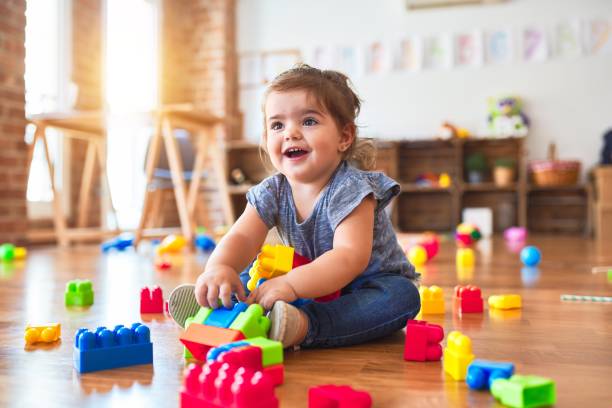Parenting is a journey filled with love, challenges, joy, and constant learning. Every parent seeks to make their child’s life better while balancing their own well-being. Here are some practical parenting hacks that can help make this beautiful journey smoother and more enjoyable.
Organization Hacks

1. Create a Family Command Center
A family command center can be a bulletin board or a wall-mounted organizer that holds your family calendar, important papers, and a to-do list. This centralizes all essential information and helps everyone stay on the same page.
2. Use Bins and Labels
Organize your child’s toys, clothes, and school supplies with bins and labels. This makes it easier for them to find and put away their things, fostering independence and reducing clutter.
3. Prepare Outfits for the Week
Save time on busy mornings by preparing your child’s outfits for the week in advance. Use a hanging organizer with labeled compartments for each day of the week.
4. Meal Planning
Plan your meals for the week to save time and reduce stress. Make a shopping list based on your meal plan to ensure you have all the necessary ingredients.
5. Utilize a Chore Chart
A chore chart helps teach responsibility and accountability. Assign age-appropriate chores and use stickers or checkmarks to track progress. Reward completed chores with small incentives.
Meal Preparation Hacks

1. Batch Cooking
Prepare large batches of meals and freeze them in portions. This is particularly useful for busy weekdays when you don’t have time to cook from scratch.
2. Use a Slow Cooker or Instant Pot
Slow cookers and Instant Pots are great for preparing healthy meals with minimal effort. Just add your ingredients, set the timer, and let the appliance do the work.
3. Make Snacks Accessible
Keep healthy snacks like fruits, vegetables, and yogurt at a height where your child can easily reach them. This encourages independent snacking and reduces interruptions.
4. Involve Kids in Cooking
Involve your children in meal preparation. This not only teaches them valuable life skills but also makes them more likely to try new foods.
5. Prep Ingredients in Advance
Wash, chop, and portion out ingredients ahead of time. Store them in clear containers in the fridge to save time when you’re ready to cook.
Sleep Hacks

1. Establish a Bedtime Routine
A consistent bedtime routine helps signal to your child that it’s time to wind down. Include activities like a warm bath, reading a book, or gentle music.
2. Use Blackout Curtains
Blackout curtains can help create a dark, conducive environment for sleep, especially during the summer months when it stays light later.
3. Create a Sleep-Friendly Environment
Keep your child’s room cool, quiet, and comfortable. Use white noise machines if necessary to block out external sounds.
4. Limit Screen Time Before Bed
Avoid screens at least an hour before bedtime. The blue light emitted by screens can interfere with the production of melatonin, the sleep hormone.
5. Encourage a Relaxing Pre-Sleep Activity
Activities like coloring, puzzles, or quiet play can help your child relax before bedtime. Avoid stimulating activities like running or roughhousing.
Behavioral Hacks

1. Use Positive Reinforcement
Reward good behavior with praise, stickers, or a small treat. Positive reinforcement encourages your child to repeat the behavior.
2. Set Clear Expectations
Be clear and consistent with your expectations. Children are more likely to follow rules if they understand them and know the consequences of breaking them.
3. Use Time-Outs Effectively
If your child misbehaves, a time-out can be a useful tool. Keep time-outs brief and consistent, and explain why the behavior was unacceptable.
4. Offer Choices
Giving your child choices fosters independence and reduces power struggles. For example, let them choose between two outfits or two snacks.
5. Model Desired Behavior
Children learn by observing. Model the behavior you want to see in your child, whether it’s good manners, empathy, or patience.
Health and Safety Hacks

1. Keep a First-Aid Kit Handy
Have a well-stocked first-aid kit in your home and car. Include items like band-aids, antiseptic wipes, tweezers, and pain relievers.
2. Teach Basic Safety Rules
Teach your child basic safety rules, such as not talking to strangers, looking both ways before crossing the street, and what to do in case of an emergency.
3. Use Childproofing Products
Childproof your home by using products like outlet covers, cabinet locks, and corner protectors. Regularly check your home for potential hazards.
4. Practice Good Hygiene
Encourage regular handwashing, especially before meals and after using the bathroom. Teach your child to cover their mouth when coughing or sneezing.
5. Schedule Regular Check-Ups
Keep up with regular pediatrician visits, dental check-ups, and immunizations. Early detection of health issues can make a big difference.
Educational Hacks

1. Create a Learning-Friendly Environment
Designate a quiet, well-lit area for homework and reading. Stock it with necessary supplies like pencils, paper, and books.
2. Use Educational Apps and Games
Incorporate technology into learning by using educational apps and games. These tools can make learning fun and interactive.
3. Encourage Reading
Read to your child daily and encourage independent reading. Visit the library regularly and let your child choose books that interest them.
4. Make Learning Fun
Incorporate learning into everyday activities. Cook together to teach measurements, play board games to practice math skills, and explore nature to learn about science.
5. Stay Involved in School
Stay in regular contact with your child’s teachers and attend school events. Being involved shows your child that you value their education.
Travel Hacks

1. Pack Smart
Pack light and bring only essential items. Use packing cubes to organize clothes and separate items. Bring a small backpack with snacks, toys, and activities to keep your child occupied.
2. Use Travel-Friendly Gear
Invest in travel-friendly gear like a lightweight stroller, portable crib, and compact car seat. These items make traveling with kids more manageable.
3. Plan Ahead
Research your destination and plan activities that are child-friendly. Make reservations in advance to avoid long waits and ensure availability.
4. Keep a Routine
Try to maintain your child’s regular routine as much as possible. This includes meal times, nap times, and bedtime.
5. Be Flexible
Traveling with kids can be unpredictable. Be prepared to adjust your plans and go with the flow to keep everyone happy.
Self-Care Hacks for Parents

1. Prioritize Self-Care
Take time for yourself to relax and recharge. Whether it’s a bubble bath, a workout, or a night out with friends, self-care is essential for your well-being.
2. Ask for Help
Don’t be afraid to ask for help from family, friends, or a babysitter. It’s important to have a support system and take breaks when needed.
3. Practice Mindfulness
Incorporate mindfulness practices like meditation or deep breathing into your daily routine. These techniques can help reduce stress and improve mental clarity.
4. Stay Connected
Maintain connections with your partner, friends, and family. Strong relationships provide emotional support and a sense of community.
5. Set Realistic Expectations
Parenthood is full of challenges. Set realistic expectations for yourself and your family, and don’t strive for perfection. Celebrate small victories and learn from mistakes.
Technology and Gadget Hacks

1. Use Parental Controls
Set up parental controls on devices to limit screen time and access to inappropriate content. Many devices offer built-in features to help manage usage.
2. Use Educational Apps
Incorporate educational apps into your child’s screen time. These apps can make learning fun and interactive.
3. Limit Screen Time
Set limits on screen time to ensure your child has a healthy balance of activities. Encourage outdoor play, reading, and creative activities.
4. Use Technology for Organization
Use apps and digital calendars to stay organized. Set reminders for appointments, activities, and important tasks.
5. Embrace Smart Home Devices
Smart home devices like video doorbells, smart thermostats, and voice assistants can make your home more efficient and secure.
Conclusion
Parenting is a rewarding yet challenging journey. By incorporating these parenting hacks into your daily routine, you can make the experience more enjoyable and less stressful for both you and your child. Remember, the goal is to create a happy, healthy, and loving environment where your child can thrive. Embrace the journey and cherish the moments, as they grow up fast.
FAQ (Frequently Asked Questions)
1. What are the benefits of using a family command center?
A family command center centralizes important information, helping everyone in the household stay organized and informed. It can reduce chaos and ensure that everyone knows their schedules, tasks, and responsibilities.
2. How can I make meal prep easier with kids?
Involve your children in meal preparation by giving them age-appropriate tasks. This not only makes meal prep easier but also teaches them valuable life skills. Additionally, batch cooking and using appliances like slow cookers or Instant Pots can save time and effort.
3. What are some effective ways to establish a bedtime routine?
Establishing a bedtime routine can include activities like a warm bath, reading a book, or listening to gentle music. Consistency is key, so try to follow the same routine every night to signal to your child that it’s time to wind down and sleep.
4. How can I encourage my child to follow rules and behave well?
Positive reinforcement, setting clear expectations, and offering choices can help encourage good behavior. Rewarding positive actions with praise or small incentives can motivate your child to continue behaving well.
5. What should I include in a home first-aid kit?
A home first-aid kit should include band-aids, antiseptic wipes, tweezers, pain relievers, gauze pads, adhesive tape, and any necessary medications. It’s also helpful to have a guide on basic first aid.





